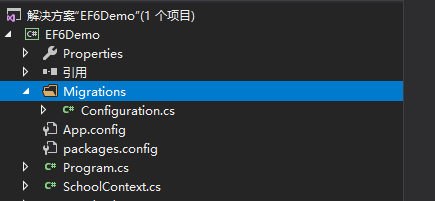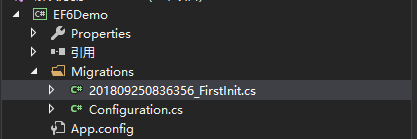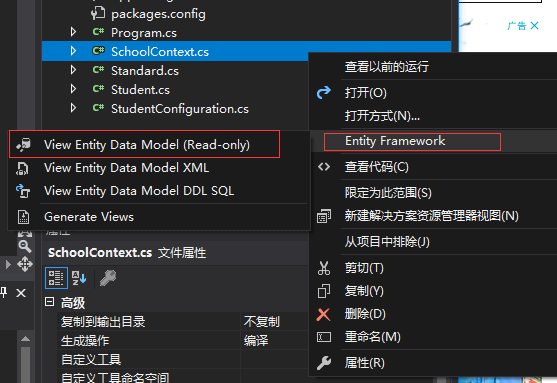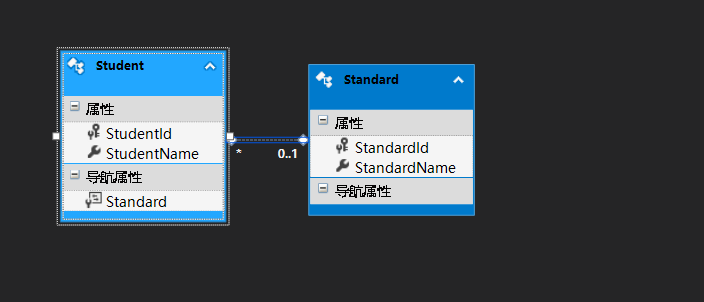EF CodeFirst系列(8)---添加初始化数据和数据库迁移策略
1.添加初始化数据(Seed)
我们可以在初始化数据库的过程中给数据库添加一些数据。为了实现初始化数据(seed data)我们必须创建一个自定义的数据库初始化器(DB initializer),并重写其中的Seed方法。
下边的栗子展示在School数据库中给Standard表添加默认的数据:
第一步:创建自定义初始化器
//继承三种内置的初始化器中的DropCreateDatabaseAlways public class SchoolDBInitializer : DropCreateDatabaseAlways<SchoolDBContext> { protected override void Seed(SchoolDBContext context) { IList<Standard> defaultStandards = new List<Standard>(); defaultStandards.Add(new Standard() { StandardName = "Standard 1", Description = "First Standard" }); defaultStandards.Add(new Standard() { StandardName = "Standard 2", Description = "Second Standard" }); defaultStandards.Add(new Standard() { StandardName = "Standard 3", Description = "Third Standard" }); context.Standards.AddRange(defaultStandards); //初始化数据 base.Seed(context); } }
第二步.将自定义的数据库初始化器添加到context中
public class SchoolContext: DbContext { public SchoolContext(): base("SchoolDB") { Database.SetInitializer(new SchoolDBInitializer()); } public DbSet<Student> Students { get; set; } public DbSet<Standard> Standards { get; set; } }
2.数据库迁移策略
前边我们已经知道了EF中的数据库迁移策略(CreateDatabaseIfNotExists,DropCreateDatabaseIfModelChanges, and DropCreateDatabaseAlways.),但是因为这些策略都是删除旧的数据库然后创建一个新的数据库,所以使用这些策略会造成数据库中的数据(不是seed data的数据)、存储过程、触发器等内容丢失。
针对上边的问题,EF提供了一个新的数据库初始化器 MigrateDatabaseToLastestVersion,这个工具在实体模型改变时自动帮我们更新数据库,且不会造成数据丢失。
下边介绍两种更新数据库的方法:
1.自动迁移
第一步:
在程序包管理器控制台输入
enable-migrations –EnableAutomaticMigration:$true
执行成功后,EFAp创建了一个继承自DbMigrationConfiguration类的Configuration类,如下
internal sealed class Configuration : DbMigrationsConfiguration<EF6Demo.SchoolContext> { public Configuration() { AutomaticMigrationsEnabled = true;//自动迁移为true AutomaticMigrationDataLossAllowed = true;//允许数据丢失,默认生成时没有这一项(不添加这一项时,只在添加/删除实体类时自动生成,如果我们删除了实体类的一个属性就会抛出异常) ContextKey = "EF6Demo.SchoolContext"; } protected override void Seed(EF6Demo.SchoolContext context) { // This method will be called after migrating to the latest version. // You can use the DbSet<T>.AddOrUpdate() helper extension method // to avoid creating duplicate seed data. } }
第二步:
把数据库初始化器添加到配置中,context代码如下:
public class SchoolContext : DbContext { public SchoolContext() { //添加MigrateDatabaseToLatestVersion数据库初始化器 Database.SetInitializer(new MigrateDatabaseToLatestVersion<SchoolContext, Configuration>()); } public virtual DbSet<Student> Students { get; set; } public virtual DbSet<Standard> Standards { get; set; } protected override void OnModelCreating(DbModelBuilder modelBuilder) { base.OnModelCreating(modelBuilder); } }
完成上边两步,当我们修改实体类时运行程序就会自动更新数据库。
2.使用代码迁移
上边我们了解了通过自动迁移来更新数据库,这里介绍通过代码更新数据库的方法。通过代码更新数据库的功能更强大,如我们可以给数据库的列添加默认值,添加计算列等。
使用代码迁移,我们在程序包控制台执行以下过程:
1.Enable-Migrations [-f]
这条命令会生成一个Configuration文件,当配置文件存在时可通过-f后缀强制覆盖旧文件。执行成功后添加了Migrations文件夹,文件夹中包含一个Configuration配置类,如下:

Configuration配置类代码如下:
internal sealed class Configuration : DbMigrationsConfiguration<EF6Demo.SchoolContext> { public Configuration() { AutomaticMigrationsEnabled = false; ContextKey = "EF6Demo.SchoolContext"; } protected override void Seed(EF6Demo.SchoolContext context) { // This method will be called after migrating to the latest version. // You can use the DbSet<T>.AddOrUpdate() helper extension method // to avoid creating duplicate seed data. } }
2.Add-Migration [MigName]
首先在context类中指定初始化器是MigrateDatabaseToLatestVersion初始化器,如下:
public class SchoolContext : DbContext { public SchoolContext() { //添加MigrateDatabaseToLatestVersion数据库初始化器 Database.SetInitializer(new MigrateDatabaseToLatestVersion<SchoolContext, Configuration>()); } public virtual DbSet<Student> Students { get; set; } public virtual DbSet<Standard> Standards { get; set; } protected override void OnModelCreating(DbModelBuilder modelBuilder) { base.OnModelCreating(modelBuilder); } }
在包管理器控制台执行:
Add-Migration FirstInit
这会在Migration文件夹中生成一个<stamp>_name的迁移类:

迁移类的代码如下:
public partial class FirstInit : DbMigration { //升级 public override void Up() { CreateTable( "dbo.Standards", c => new { StandardId = c.Int(nullable: false, identity: true), StandardName = c.String(), }) .PrimaryKey(t => t.StandardId); CreateTable( "dbo.Students", c => new { StudentId = c.Int(nullable: false, identity: true), StudentName = c.String(), Standard_StandardId = c.Int(), }) .PrimaryKey(t => t.StudentId) .ForeignKey("dbo.Standards", t => t.Standard_StandardId) .Index(t => t.Standard_StandardId); } //降级 public override void Down() { DropForeignKey("dbo.Students", "Standard_StandardId", "dbo.Standards"); DropIndex("dbo.Students", new[] { "Standard_StandardId" }); DropTable("dbo.Students"); DropTable("dbo.Standards"); } }
我们可以看到迁移类中包含Up()和Down()方法,分别用于数据库的更新和回退。
3.Update-Database
① updata-database [-verbose]
在程序包控制台中执行这条命令时,会执行Add-Migration命令创建的最新的迁移文件,并更新数据库。
执行完上边三步数据库就生成了,以后当我们修改实体类时,执行Add-Migration [MigName]后再执行Update-Database [-verbose],就可方便地根据模型的变化更新数据库。
② update-database -TargetMigration:xxx
如果我们想回退到某一个版本时执行:
update-database -TargetMigration:FirstInit//数据库回退到第一次的版本
3.codeFirst中的设计器
我们知道codeFirst模式中不支持设计器,设计器对我们理解实体间关系还是很有用的,怎么在code-first中使用设计器呢?Visual Studio Marketplace.点击链接下载工具,安装即可,安装完成重启VS,在context上点击右键,然后会有一个Entity Framework选项,如下图:

点击ViewEntity Data Model选项就可以自动生成设计器,如下:

这个工具十分好用,同时也支持生成Model XML和DDL SQL推荐使用。


 浙公网安备 33010602011771号
浙公网安备 33010602011771号